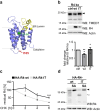RHBDL4-triggered downregulation of COPII adaptor protein TMED7 suppresses TLR4-mediated inflammatory signaling
- PMID: 38453906
- PMCID: PMC10920636
- DOI: 10.1038/s41467-024-45615-2
RHBDL4-triggered downregulation of COPII adaptor protein TMED7 suppresses TLR4-mediated inflammatory signaling
Abstract
The toll-like receptor 4 (TLR4) is a central regulator of innate immunity that primarily recognizes bacterial lipopolysaccharide cell wall constituents to trigger cytokine secretion. We identify the intramembrane protease RHBDL4 as a negative regulator of TLR4 signaling. We show that RHBDL4 triggers degradation of TLR4's trafficking factor TMED7. This counteracts TLR4 transport to the cell surface. Notably, TLR4 activation mediates transcriptional upregulation of RHBDL4 thereby inducing a negative feedback loop to reduce TLR4 trafficking to the plasma membrane. This secretory cargo tuning mechanism prevents the over-activation of TLR4-dependent signaling in an in vitro Mycobacterium tuberculosis macrophage infection model and consequently alleviates septic shock in a mouse model. A hypomorphic RHBDL4 mutation linked to Kawasaki syndrome, an ill-defined inflammatory disorder in children, further supports the pathophysiological relevance of our findings. In this work, we identify an RHBDL4-mediated axis that acts as a rheostat to prevent over-activation of the TLR4 pathway.
© 2024. The Author(s).
Conflict of interest statement
The authors declare no competing interests.
Figures







Similar articles
-
The COP II adaptor protein TMED7 is required to initiate and mediate the delivery of TLR4 to the plasma membrane.Sci Signal. 2014 Jul 29;7(336):ra70. doi: 10.1126/scisignal.2005275. Sci Signal. 2014. PMID: 25074978 Free PMC article.
-
The GOLD domain-containing protein TMED7 inhibits TLR4 signalling from the endosome upon LPS stimulation.Nat Commun. 2012 Feb 28;3:707. doi: 10.1038/ncomms1706. Nat Commun. 2012. PMID: 22426228
-
The metabolic regulator Lamtor5 suppresses inflammatory signaling via regulating mTOR-mediated TLR4 degradation.Cell Mol Immunol. 2020 Oct;17(10):1063-1076. doi: 10.1038/s41423-019-0281-6. Epub 2019 Aug 29. Cell Mol Immunol. 2020. PMID: 31467416 Free PMC article.
-
Functional interfaces between TICAM-2/TRAM and TICAM-1/TRIF in TLR4 signaling.Biochem Soc Trans. 2017 Aug 15;45(4):929-935. doi: 10.1042/BST20160259. Epub 2017 Jun 19. Biochem Soc Trans. 2017. PMID: 28630139 Review.
-
TLR4 and CD14 trafficking and its influence on LPS-induced pro-inflammatory signaling.Cell Mol Life Sci. 2021 Feb;78(4):1233-1261. doi: 10.1007/s00018-020-03656-y. Epub 2020 Oct 15. Cell Mol Life Sci. 2021. PMID: 33057840 Free PMC article. Review.
Cited by
-
Pattern recognition receptors: function, regulation and therapeutic potential.Signal Transduct Target Ther. 2025 Jul 11;10(1):216. doi: 10.1038/s41392-025-02264-1. Signal Transduct Target Ther. 2025. PMID: 40640149 Free PMC article. Review.
-
Activity-Based Protein Profiling of RHBDL4 Reveals Proteolysis of the Enzyme and a Distinct Inhibitor Profile.ACS Chem Biol. 2024 Aug 16;19(8):1674-1682. doi: 10.1021/acschembio.4c00273. Epub 2024 Jul 23. ACS Chem Biol. 2024. PMID: 39041925 Free PMC article.
-
Toll-like receptor signaling in teleosts.Sci China Life Sci. 2025 Jul;68(7):1889-1911. doi: 10.1007/s11427-024-2822-5. Epub 2025 Feb 14. Sci China Life Sci. 2025. PMID: 39961973 Review.
-
MiR-370-3p regulate TLR4/SLC7A11/GPX4 to alleviate the progression of glucocorticoids-induced osteonecrosis of the femoral head by promoting osteogenesis and suppressing ferroptosis.J Orthop Translat. 2025 Feb 12;51:337-358. doi: 10.1016/j.jot.2024.10.014. eCollection 2025 Mar. J Orthop Translat. 2025. PMID: 40584015 Free PMC article.
-
Cyclic N, O-acetals and corresponding opened N, N-aminals as new scaffolds with promising anti-inflammatory and antifungal activities against Candida albicans.Sci Rep. 2025 Mar 11;15(1):8364. doi: 10.1038/s41598-025-92635-z. Sci Rep. 2025. PMID: 40069300 Free PMC article.
References
MeSH terms
Substances
Grants and funding
LinkOut - more resources
Full Text Sources
Molecular Biology Databases

